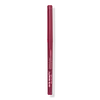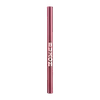What's inside
What's inside
 Key Ingredients
Key Ingredients

 Benefits
Benefits

No benefits
 Concerns
Concerns

 Ingredients Side-by-side
Ingredients Side-by-side

Iron Oxides
CI 77491
Cosmetic ColorantCI 77492
Cosmetic ColorantCI 77499
Cosmetic ColorantMica
Cosmetic ColorantTitanium Dioxide
Cosmetic ColorantCI 19140
Cosmetic ColorantCI 15850
Cosmetic ColorantIsododecane
EmollientSynthetic Wax
AbrasivePolybutene
Trimethylsiloxysilicate
EmollientSilica
AbrasiveSucrose Tetrastearate Triacetate
EmollientHydrogenated Jojoba Oil
AbrasiveCetearyl Behenate
EmollientIsoamyl Laurate
EmollientEthylhexyl Palmitate
EmollientTribehenin
EmollientSynthetic Fluorphlogopite
Pentaerythrityl Tetra-Di-T-Butyl Hydroxyhydrocinnamate
AntioxidantHydrocinnamyl Cinnamate
PerfumingBlue 1 Lake
Cosmetic ColorantCI 45380
Cosmetic ColorantSorbitan Isostearate
EmulsifyingLactic Acid
BufferingIron Oxides, CI 77491, CI 77492, CI 77499, Mica, Titanium Dioxide, CI 19140, CI 15850, Isododecane, Synthetic Wax, Polybutene, Trimethylsiloxysilicate, Silica, Sucrose Tetrastearate Triacetate, Hydrogenated Jojoba Oil, Cetearyl Behenate, Isoamyl Laurate, Ethylhexyl Palmitate, Tribehenin, Synthetic Fluorphlogopite, Pentaerythrityl Tetra-Di-T-Butyl Hydroxyhydrocinnamate, Hydrocinnamyl Cinnamate, Blue 1 Lake, CI 45380, Sorbitan Isostearate, Lactic Acid
Dimethicone
EmollientHydrogenated Microcrystalline Wax
Emulsion StabilisingSynthetic Beeswax
Emulsion StabilisingPolybutene
Neopentyl Glycol Diheptanoate
EmollientTrimethylsiloxysilicate
EmollientCopernicia Cerifera Wax
Isododecane
EmollientIsoamyl Laurate
EmollientPersea Gratissima Oil
Skin ConditioningPalmitoyl Tripeptide-1
Skin ConditioningTocopherol
AntioxidantHelianthus Annuus Seed Oil
EmollientTalc
AbrasiveEthylhexyl Palmitate
EmollientTribehenin
EmollientSorbitan Isostearate
EmulsifyingLactic Acid
BufferingMica
Cosmetic ColorantCI 77891
Cosmetic ColorantIron Oxides
CI 42090
Cosmetic ColorantCI 75470
Cosmetic ColorantCI 77742
Cosmetic ColorantCI 15850
Cosmetic ColorantCI 16035
Cosmetic ColorantDimethicone, Hydrogenated Microcrystalline Wax, Synthetic Beeswax, Polybutene, Neopentyl Glycol Diheptanoate, Trimethylsiloxysilicate, Copernicia Cerifera Wax, Isododecane, Isoamyl Laurate, Persea Gratissima Oil, Palmitoyl Tripeptide-1, Tocopherol, Helianthus Annuus Seed Oil, Talc, Ethylhexyl Palmitate, Tribehenin, Sorbitan Isostearate, Lactic Acid, Mica, CI 77891, Iron Oxides, CI 42090, CI 75470, CI 77742, CI 15850, CI 16035
Ingredients Explained
These ingredients are found in both products.
Ingredients higher up in an ingredient list are typically present in a larger amount.
Ci 15850 is the pigment color red. It is an azo dye and created synthetically.
Azo dyes need to be thoroughly purified before use. This allows them to be more stable and longer-lasting.
This ingredient is common in foundations, lipsticks, and blushes. This color is described as brown/orangey red.
It has many secondary names such as Red 6 and Red 7. According to a manufacturer, Red 6 usually contains aluminum.
Learn more about CI 15850Ethylhexyl Palmitate, also known as octyl palmitate, is created from 2-ethylhexyl alcohol and palmitic acid. It is a fatty acid ester.
The fatty acid content of Ethylhexyl Palmitate makes it an emollient. Emollients help soften and hydrate your skin by trapping moisture within.
Ethylhexyl Palmitate is also used to help improve the texture of cosmetics. It helps other ingredient dissolve in products and help disperse ingredients more evenly.
You'll likely find this ingredient in sunscreen, as it is often used to mix UV-blocking ingredients such as avobenzone and ethylhexyl triazone.
It can also help stabilize the fragrances in a product as a fragrance fixative.
Ethylhexyl Palmitate can be used to substitute mineral oil.
Due to its high fatty acid content, it may not be fungal-acne safe.
Learn more about Ethylhexyl PalmitateIsoamyl Laurate is created from isoamyl alcohol and lauric acid. It is an emollient and traps moisture underneath.
This ingredient helps give products a silky feel and is considered a silicone alternative.
This ingredient may not be fungal acne safe.
Learn more about Isoamyl LaurateIsododecane is a fragrance, emollient, and solvent.
As an emollient, it helps your skin stay soft and hydrated. Emollients help trap moisture into your skin.
Isododecane's role as a solvent makes it a great texture enhancer. It spreads smoothly on skin and does not leave a sticky feeling behind. Isododecane also helps prevent color transfer in makeup products.
Isododecane is not absorbed into skin.
Learn more about IsododecaneLactic Acid is another well-loved alpha hydroxy acid (AHA). It is gentler than glycolic acid but still highly effective.
Its main role is to exfoliate the surface of the skin by loosening the “glue” that holds dead skin cells together. Shedding those old cells leads to smoother, softer, and more even-toned skin.
Because lactic acid molecules are larger than glycolic acid, they don’t penetrate as deeply. This means they’re less likely to sting or irritate, making it a great choice for beginners or those with sensitive skin.
Like glycolic acid, it can:
Lactic acid also acts as a humectant (like hyaluronic acid). It can draw water into the skin to improve hydration and also plays a role in the skin's natural moisturizing factor (NMF) in the form of sodium lactate.
Studies show it can boost ceramide production to strengthen the skin barrier and even help balance the skin’s microbiome.
To get results, choose products with a pH between 3-4.
Lower strengths (5-12%) focus on surface exfoliation; higher strengths (12% and up) can reach deeper in the dermis (deeper, supportive layer) to improve skin texture and firmness over time.
Though it was originally derived from milk, most modern lactic acid used in skincare is vegan. It is made through non-dairy fermentation to create a bio-identical and stable form suitable for all formulations.
When lactic acid shows up near the end of an ingredient list, it usually means the brand added just a tiny amount to adjust the product’s pH.
Legend has it that Cleopatra used to bathe in sour milk to help reduce wrinkles.
Lactic acid is truly a gentle multitasker: it exfoliates, hydrates, strengthens, and brightens. It's a great ingredient for giving your skin a smooth, glowing, and healthy look without the harshness of stronger acids.
Read more about some other popular AHA's here:
Learn more about Lactic AcidMica is a naturally occurring mineral used to add shimmer and color in cosmetics. It can also help improve the texture of a product or give it an opaque, white/silver color.
Serecite is the name for very fine but ragged grains of mica.
This ingredient is often coated with metal oxides like titanium dioxide. Trace amounts of heavy metals may be found in mica, but these metals are not harmful in our personal products.
Mica has been used since prehistoric times throughout the world. Ancient Egyptian, Indian, Greek, Roman, Aztec, and Chinese civilizations have used mica.
Learn more about MicaPolybutene is used to help control the viscosity of a product. This just means it helps adjusts the texture.
It is a polymer and does not get absorbed into the skin due to its large size.
Studies found this ingredient did not irritate skin in concentrations below 15%.
Learn more about PolybuteneSorbitan Isostearate is an emulsifer and cleaning agent. It is created from isostearic acid and sorbitol.
As an emulsifier, Sorbitan Isostearate prevents oils and water from separating.
Due to its isostearic acid base, it may not be safe for Malassezia or fungal acne.
Learn more about Sorbitan IsostearateTribehenin comes from glycerin and behenic acid.
It is used as an emollient, or moisturizer. Emollients form a thin barrier on skin to prevent moisture from escaping.
This ingredient may not be Malassezia folliculitis, or fungal-acne safe.
Learn more about TribeheninThis silicone is an emollient. Emollients create a thin film on the skin to prevent moisture from escaping.
It is not soluble in water and helps increase water-resistance in products.
According to a manufacturer, it can blend seamlessly with silicone oils, such as Cyclopentasiloxane.
Learn more about TrimethylsiloxysilicateThis ingredient is a combination of red, black, and yellow iron oxide pigments. This combination of colors is usually found in foundation, because it results in a "skin" color.